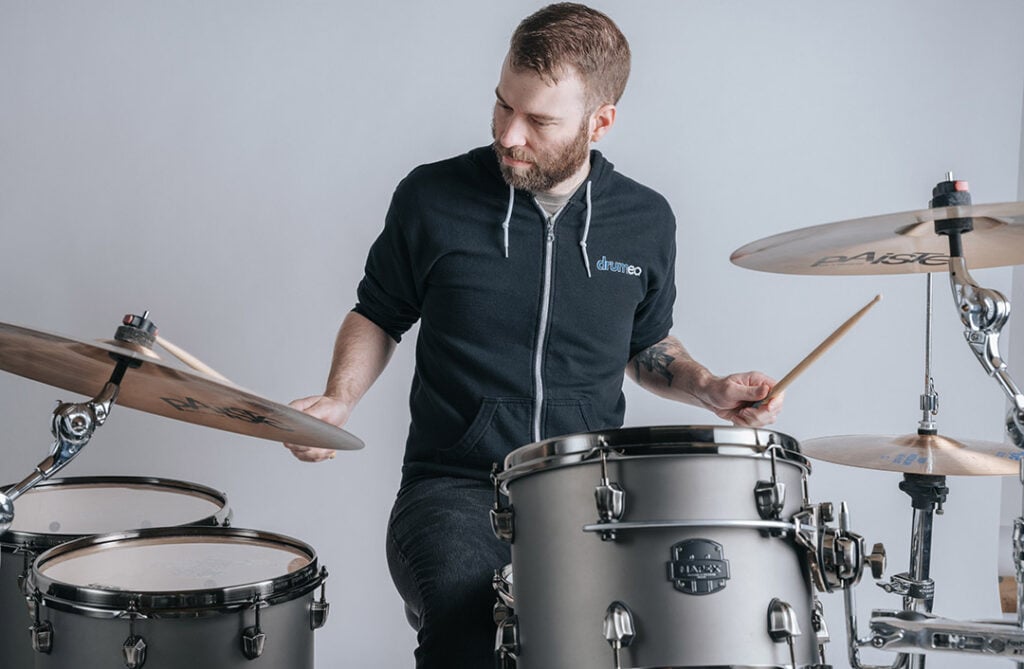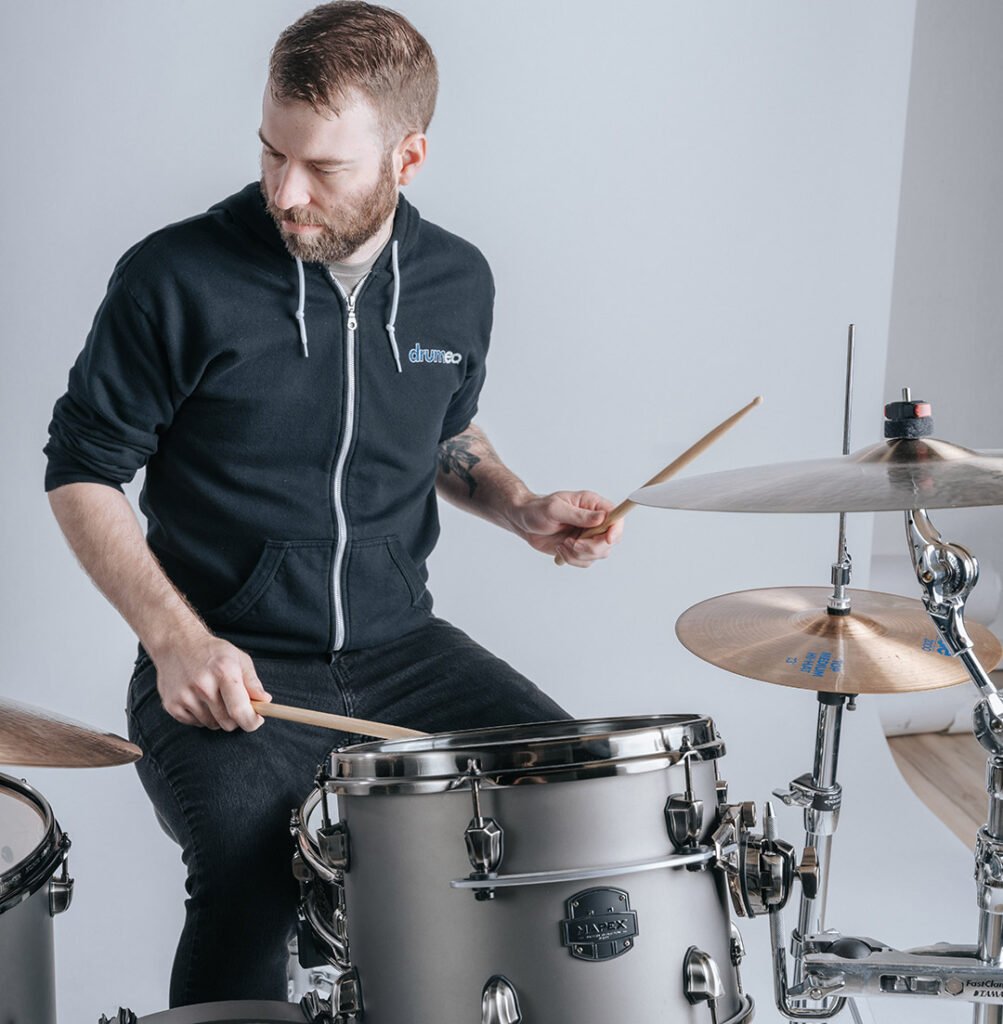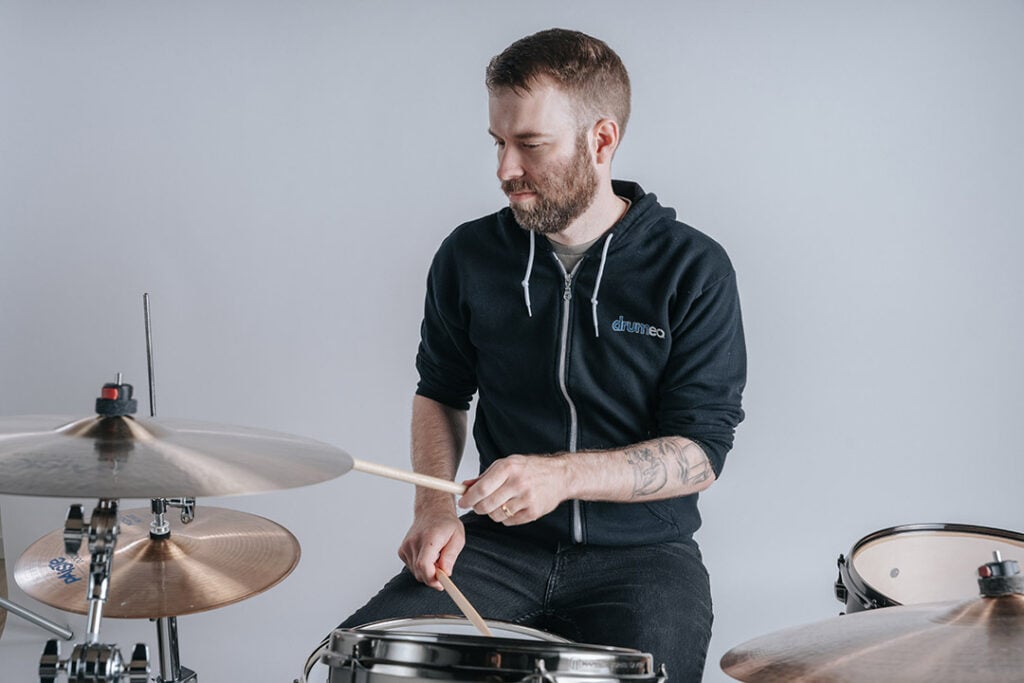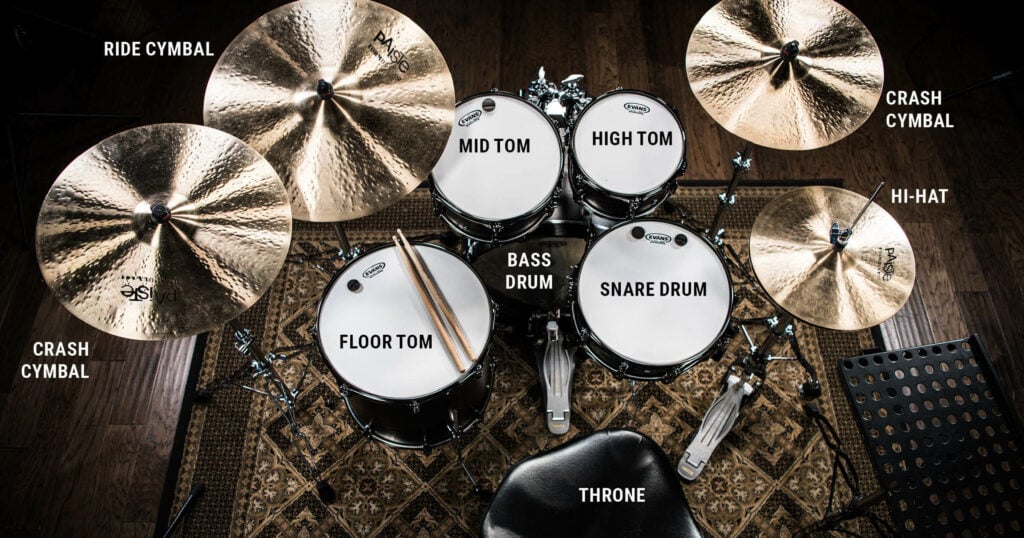
Sure, most drummers are right-handed…but what about good advice for left-handed drummers?
About 10% of the population are lefties. If you’re learning the drums, you’ll quickly find that like most things, the drum kit is usually set up for someone who’s right side dominant.
However, the beauty of drum kits is that they’re modular, which means you can set them up in any way that best vibes with your body. Each piece of the drum set can work for a lefty or a righty.
There’s no wrong way to learn the drums if it means that you’re comfortable when playing.
Get access to the beginner video course that’ll have you confidently playing along with your favorite songs in just 90 days: New Drummers Start Here.
If you’re just starting on the drums, you need to decide how to set up your kit. Righties have it easy: most kits are set up for right-handed playing, and most drum teachers tend to start new drummers on right-handed setups.
Lefties have to make a choice. You can:
We’re going to cover all three of these options, talk about how to strengthen your right side, and leverage your stronger left side.
How do the big lefty names like Billy Cobham and Ian Paice do it? Let’s find out.
This might seem like a stupid thing to say. “I’ve known myself my entire life. I would know if I’m left-handed.”
That’s fair. But are you a left-handed drummer?
If you write with your left hand, you’d assume that you’d be a left-handed drummer, right? That’s not always the case. Our bodies sometimes don’t make sense. Have you ever gone snowboarding or kicked a ball? Do you do everything with your left side?
It’s possible you’ll feel more comfortable playing on a righty setup.
A good way to find out if you’re a lefty drummer is by sitting at the kit and seeing which side of your body feels more comfortable when playing. Do you naturally start fills with your left hand? Does your left foot feel more dominant than your right?
If you favor the left side of your body more when playing anything on the kit, you’re probably a true lefty drummer, and you may want your bass drum foot kicking on the left as well.
So what’s next?
You can fight your body’s natural comfort by learning to play right-handed from the get-go. This will benefit you in the long run when it comes to playing on drum kit setups other than your own. Want to sit in on a jam session? The house kit will be set up for righties.

The downside is that your body will be itching to lead with your left hand. Your right foot may also feel weaker than your left, and kicking away at the bass drum might feel unnatural. By forcing yourself to play like a right-handed drummer, the learning curve at the beginning will probably be steeper for you.
However, if you can push past the early struggles, you may have an advantage over right-handed players. If your left side is naturally stronger but you’ve taught your right side to keep up, you could become an ambidextrous drummer.
Ringo Starr is one example of a left-handed drummer who plays on a right-handed kit. He leads many of his fills with his left hand, which results in some iconic orchestrations!
Click here to learn how to set up a right-handed drum kit
If you’re comfortable playing the bass drum with your right foot but you’d rather your left hand be your primary hand, open-handed playing is the way to go. You’ll be able to sit down on any drum set and play (although some set their ride cymbal to the left of the hi-hat)

Open-handed drumming gives you wider access to all the drums and cymbals. This way, you can play certain beats and fills you wouldn’t be able to if you had to cross your arms.
Even some right-handed drummers like to play open-handed because of how many more patterns you can play.
The downside is that most educational drum content is aimed at cross-handed players, so you’ll have to adjust as you learn.
Here’s a clip of Claus Hessler giving the rundown of open-handed playing:
To summarize, this drumming style allows you to lead your beats and fills with your left hand. You may need to work harder to improve your right foot on the bass drum, though.
With an open-handed stance, your rolls around the kit will feel natural, you can get unique sounds, and play certain patterns that cross-armed players can’t.
In a left-handed drum setup, everything is – you guessed it – opposite to a right-handed setup. It’s like looking at a right-handed kit in a mirror.

If this is your preferred kit setup, keep in mind that it may limit you if you don’t learn to play a right-handed setup too. If you ever need to play someone else’s drums in a live setting – like during an open jam or on a festival backline – you may not have enough time to switch everything around and put it back for the next drummer.
This is why many lefties opt to play on right-handed kits.
But stay unapologetic in your preferences. If playing a left-handed setup will inspire you to practice and play more, go for it!
Check out Daniel Glass ripping it up on a lefty kit:
It’s just as easy to set up a kit lefty-style as it is righty-style. All you have to do is reverse the ‘standard’ drum kit setup.
Your hi-hats and snare will go on your right side, while your ride cymbal and floor tom will go on your left side. The rack toms can be placed according to your preference, as some drummers dig the sound of a bigger rack tom being in the middle.

You don’t need ‘left-handed gear’ with a standard drum setup, as most drum gear can easily be played from either side. However, you could get a left-handed pedal if you want to play double bass (shop left-handed pedals in Europe).
Whether you play on a left-handed or right-handed kit, improving your non-dominant hand will better your overall drumming skills. A great way of practicing this is by leading grooves and fills with your right hand and going through exercises that help even out your hands and feet:
Play one hand at a time in groups of four or eight.

Play consistent notes with only your right hand or your non-dominant foot (this develops endurance).

Play short bursts with only your right hand or non-dominant foot (this develops speed).

Go through this 30-minute workout with Heather Thomas when you have time. The exercises come from Stick Control by George Lawrence (one of the most popular timeless drumming books). You’ll definitely feel your weaker side catching up after this workout!
Read: “192 Drum Beats You Can Play With The Stick Control Book”
Take advantage of the fact that your left side naturally wants to do all the heavy lifting. While we’d all love total limb independence around the kit, most of us haven’t gotten to that point yet.
The cool thing is that you can use your body’s stronger side to support your weaker side. A good way of doing this is by playing patterns that alternate sticking. Let’s take a single paradiddle, for example:

You can start it with your left hand, but it alternates so that your right hand leads it after every four notes. Since your left hand is stronger, you’ll feel confident with that pattern, so try to train your right hand to match. The same concept applies to your feet if you’re playing double bass.
Whether you’re playing on a right-handed setup or a left-handed setup, if a song needs a powerful crash groove in the chorus, use your left hand to whack that crash cymbal. Your right hand probably wouldn’t do that song the justice it deserves.
Watching right-handed drummers play with cross-over stances won’t be as relatable if you’re a lefty. A great way to find some inspiration is by watching left-handed drummers play. Some of them use left-handed sets, while others play open-handed.
It helps to see what they’re doing so you can try it too. Remember, the best drum setup is the one that will inspire you to practice, and checking out these southpaws can keep you motivated:
As a lefty, you’re just as likely to succeed on the drums as a righty. Embrace who you are, practice regularly, and enjoy what you do!
Drumeo Team - We're professional, award-winning drummers and drum teachers, coaches, recording artists, and content specialists who are passionate about drums and helping drummers around the world. This post was written and/or edited by Sam Landa, Brandon Toews, Jared Falk, Dave Atkinson, or another pro on our team (which has a combined 1000+ years of drumming experience). Are you looking for inspiration, education, and support to take your playing to the next level? Join the Drumeo community today!


By signing up you’ll also receive our ongoing free lessons and special offers. Don’t worry, we value your privacy and you can unsubscribe at any time.
We use cookies for traffic data and advertising. Cookie Policy »